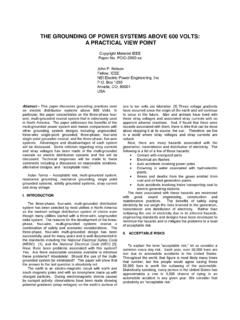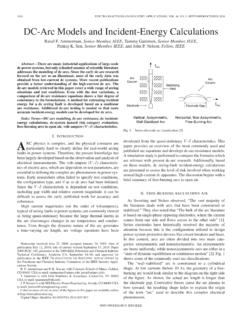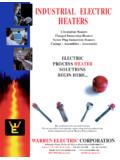Transcription of Carson Bates David Cain - NEI Electric Power Engineering
1 Engineering the Thermal Resistivity of Concrete Duct Banks Keith Malmedal Senior Member, IEEE NEI Electric Power Engineering 11049 W. 44th Ave Wheat Ridge, CO 80033, USA Bates Member, IEEE NEI Electric Power Engineering 11049 W. 44th Ave Wheat Ridge, CO 80033, USA David Cain NEI Electric Power Engineering 11049 W. 44th Ave Wheat Ridge, CO 80033, USA Abstract -- Cables are often installed in underground conduits surrounded by concrete. To calculate the cable ampacity in these duct banks the concrete thermal resistivity must be known. A set of experiments were performed to determine the effects that the concrete mixture has on resulting thermal resistivity.
2 Concrete flow fill mixtures containing water-cement-sand and water-cement-fly ash-sand were studied. Experiments showed that water content of the mixture is not a factor in final concrete thermal resistivity unless fly ash was included in the mixture, however, the water to cement ratio is significant for all mixtures. Empirical equations were derived to find the resistivity of concrete as a function of the constituents of the concrete mixture. These equations may be used to design a concrete mixture to produce a desired thermal resistivity or calculate the thermal resistivity of a known concrete mixture.
3 Index Terms-- Cable Ampacity, Duct Bank Design, Soil Moisture, Soil Properties, Thermal Conductivity, Thermal Stability, Thermoresistivity, Underground Cable Design. I. INTRODUCTION Underground conduit is often surrounded by concrete in the form of a concrete duct bank. This is done to protect the electrical conduits and their enclosed cables from damage due to excavation or traffic on the soil above the ducts. The presence of the concrete has an additional benefit of improving the negative effects of any soil thermal instability that may be suspected at a particular location.
4 Concrete improves soil thermal stability since the concrete surrounding the electrical conduit will be relatively thermally stable compared with most soils, and little water migration through hydrated concrete is expected. Furthermore, the duct bank will result in a larger area through which surrounding soil moisture can return to the drying interface between the duct bank concrete, which will be heated by the enclosed cables, and the soil in contact with the concrete. Since the drying effects on the soil will be reduced, the changes in soil thermal resistivity due to soil drying will also be reduced [1].
5 Using a concrete duct bank will thereby improve thermal stability of the underground cable system and the resulting stability will be determined to some degree by the diameter of the concrete surrounding the electrical ducts. When concrete surrounds the electrical conduits, the concrete becomes part of the thermal circuit through which heat must be conducted to escape the vicinity of the cables [2]. To calculate the ampacity of the enclosed cables the thermal resistivity of the concrete must be known. It is often desirable to have the capability of designing a concrete mix that will produce a certain target thermal resistivity.
6 It is also useful to have the means of predicting the thermal resistivity that will result when concrete of a known mixture is used. This paper examines the hypothesis that the thermal resistivity is a function of the proportioning of a concrete mixture. Two experiments were designed to test this hypothesis. The first experiment tested concrete mixtures containing cement, water and sand; and the second experiment tested mixtures containing cement, fly ash, water and sand. The experiments encompassed the complete range of concrete flow-fill mixtures commonly used in duct bank construction.
7 The results of the experiments, statistical analysis of the data, and the final design equations are reported herein. II. PROPORTIONING CONCRETE Concrete is a mixture of water, cementitious material (cement and fly ash), aggregate (sand and gravel), and air. The experiments that were performed tested the thermal resistivity of mixtures made of type II Portland Cement, sand and water; and type II Portland Cement, type F fly ash, sand and water. No air entrainment admixtures were used, and the air content was assumed to be approximately 3% in all cases.
8 All materials were procured locally from sources near Denver, Colorado. Concrete mixes have two design factors of concern. The first is water content, which affects workability and controls concrete slump. The second is water to cementitious material ratio (w/c ratio) which controls concrete compressive strength, usually given in pounds per square inch (psi). If fly ash is used to replace some of the cement then an additional design factor will be the ratio of fly ash to cementitious material [3]. The water content needed for a target slump value is calculated in lbs/yd3 of final concrete volume.
9 Slump is a measure of the workability (viscosity) of the concrete. Increasing the water content increases the slump and makes the concrete more fluid. Lower slump results in a stiffer mixture. The slump for the mixtures used in this study was between 2 inches and 7 inches, resulting from a water content of 350 lbs/yd3 to 420 lbs/yd3. Concrete strength is determined by the ratio of the water to the cementitious material (w/c). This is the mass of the water divided by the mass of the cementitious material. In this study w/c ratios between and were studied.
10 These w/c ratios will produce concrete strengths ranging between approximately 1500 psi and 7000 psi [3]. Cement is sometimes replaced with fly ash in concrete mixtures. This reduces the amount of cement needed in the cementitious material and also reduces the amount of water needed in the mix. The fly ash to cementitious material ratio also becomes a factor of interest. The fly ash to cementitious material ratio is normally between and (5% to 40%) and is measured by dividing the mass of fly ash by the mass of the total cementitious material needed for the desired strength.







